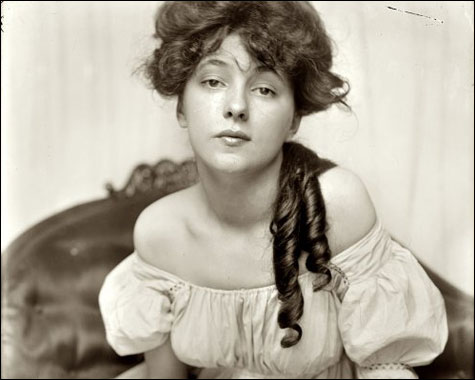
INNOCENT: Evelyn Nesbit at age 17, posed as half child and half woman by Photo-Secessionist portraitist Gertrude Käsebier. |
| American Eve: Evelyn Nesbit, Stanford White, The Birth of the “It” Girl, and the Crime of the Century | by Paula Uruburu | Riverhead Books | 372 pages | $27.95 |
Florence Evelyn Nesbit was the most beautiful woman who ever lived. So said many at the turn of the century, and looking back at the visual record of her youth, you’re hard-pressed to argue. She also had terrible taste in men and consequently became the central figure in a 1906 homicide scandal that claimed, and has maintained, the title “crime of the century.”Nesbit’s father died young, and her waifish beauty, contravening the buxom-and-pudgy Victorian ideal, made her, at age 14, America’s most popular artists’ model. Evelyn took her charms to the Broadway chorus line, from which she was snatched by society architect Stanford White, who in turn befriended, supported, and, when she was 16, raped her, after which she became his underage mistress. Mentally ill Pittsburgh millionaire heir Harry Thaw vied for her attention; he took Evelyn to Europe, where he sadistically beat her as punishment for enduring White’s “seduction.”
Evelyn nevertheless married Thaw in 1905. They lived in Pittsburgh with his pious nouveau riche Presbyterian family, who held her in the kind of contempt today reserved for porn stars. Then while on a trip to New York, Thaw assassinated White during a musical staged on the roof of Madison Square Garden. The subsequent trials exposed Evelyn’s sordid past and set legal precedent for the insanity defense.
It’s a famous story, dramatized by Hollywood in the 1955 film The Girl in the Red Velvet Swing (which starred 22-year-old Joan Collins as Nesbit), and drastically reimagined as fiction by E.L. Doctorow in Ragtime. Nesbit herself published two, sometimes inconsistent, accounts: The Story of My Life (1907) and Prodigal Days (1934).
Never has this awful tale been better researched or described than in Hofstra University English professor Paula Uruburu’s American Eve, which sets a lot of records straight. To say that Uruburu takes Nesbit’s side oversimplifies the deep and subtle arguments she makes in the defamed showgirl’s defense. Uruburu defuses the obvious question — “What was she thinking?!” — by building a psychological profile in which sexual naïveté plus parental abandonment aggravated by an unearned notoriety based on looks alone adds up to certain doom. Is this telling the story from the “woman’s point of view?” Yes, but American Eve is by no means an exaggerated or strident feminist tract. And it is, after all, a woman’s story.
Through quotes from Nesbit’s autobiographies and unpublished letters (provided by Nesbit’s grandson), the maligned gilded-age femme fatale emerges as an extremely bright, articulate, and self-aware adult, but her serial abuse by an arrogant privileged pedophile and a raving madman determined to “avenge the fallen maiden” took place when she was a blooming adolescent. The path to Nesbit’s early desensitization to her own emotions was as neatly plotted by circumstances as in any hoary melodrama, and American Eve evokes nothing but righteously aimed sympathy and anger. Uruburu’s truncated account of Nesbit’s unpleasant dénouement as a reckless drug user — which only bolstered the wanton reputation wished upon her by commercial exploiters and patriarchical historians — leads up to an obscure end, in 1967, and underscores her tragedy in a way that seems to settle the longstanding victim-or-vixen question once and for all. American Eve may not be the last word on this notorious turn-of-the-century triangle, but it is the most satisfying — and at the same time the most upsetting.